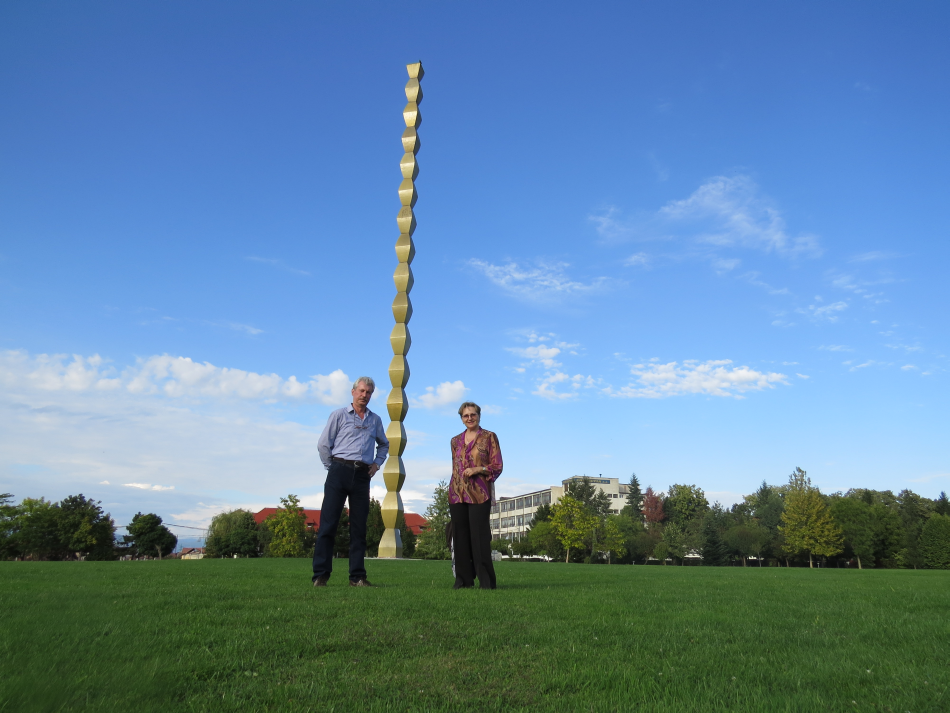Romania seen by the winners of the “Radio Romania 85” Contest
Last week, the winners of the Grand Prize of the “Radio Romania 85 Contest, Elena Kurbanova and Igor Paskarev of Ashgabat, Turkmenistan concluded their 10-day holiday in Romania.

România Internațional, 03.10.2013, 15:55
They visited 3 areas covered by regional broadcasters of the public Radio – Gorj, Timis and Cluj Counties. At the end of their holiday, Elena Kurbanova said:
Elena Kurbanova : “How many places we’ve seen, how many things we’ve been told about this country?! In such a short time, we’ve found out a lot, our programme has been very rich. We wanted to see all that was to be seen. During our holiday we visited three regional studios of Radio Romania in the cities of Craiova, Timisoara and Cluj-Napoca. These stations’ editors told us many things about the establishment of their radio stations, their work and the prospects of improving radio broadcasting. They showed us how broadcasts were prepared, they took us to their studios and concert halls. It was important for us to see all that is linked to radio broadcasting because we came to Romania by participating in the contest devoted to the 85th anniversary of Radio Romania, to be celebrated on November 1st 2013.”
Certainly, our listeners’ trip was not confined to visiting regional studios. The museums, both the open air ones and the ones hosted by famous buildings were a priority of the winners.
Elena Kurbanova said that during their journey they had visited open-air ethnographic museums with unique peasant houses, households, wooden churches built from the 15 century to the early 20th century.
Elena Kurbanova : “We visited the Cartianu half-fortified house and the Museum of Curtisoara in Gorj County, the Banat Village Museum in Timisoara and the ethnographic park in Cluj-Napoca. Worth mentioning is our visit to the sculpture compound of Constantin Brancusi, in Targu Jiu, the Gorj County Museum and the Art Museum in Targu Jiu, the Art Museum in Timisoara, which displays works by renowned Romanian painters, including Corneliu Baba’s paintings. I was impressed by his portraits of composer George Enescu. The 1989 Revolution Museum in Timisoara is quite remarkable. The museum exhibits, the historical testimonies on show there are very moving. We also visited wonderful parks such as the charming rose park in Timisoara and the Botanical Garden in Cluj- Napoca. I was greatly impressed by the salt mine in Turda. We stayed there for one hour; we went down to 120 m altitude and saw the underground lake. What is unique is the fact that the salt mine has been open since 1271.”
Elena Kurbanova said she is a great music lover, so she hadn’t missed any musical event in the places she had visited. Luckily, there were many such events.
Elena Kurbanova : “As a great music aficionado, I wanted to hear Romanian music, Romanian songs live and my wish was fulfilled with the help of my Romanian friends. We attended folk festivals in Baia de Fier, Gorj County and in Union Square in Cluj-Napoca. There we had the opportunity to listen to incendiary traditional songs with performers from all regions of Romania. We also danced a circle folk dance, we danced whole-heartedly. Complying with our request, they took us to a concert of the Banatul Philharmonic Orchestra in Timisoara, where we had the happy opportunity of listening to the wonderful music of the brilliant composer George Enescu. We didn’t miss modern Romanian music either. In Cluj-Napoca, we went to the concert of the Nightlosers band. I liked the blend of genres: rock, blues and Romanian traditional elements.”
Probably used to the architectural landscape of their native country, whose population is predominantly Muslim, Elena and Igor, Orthodox Christians, were impressed by the large number of churches and Romanians’ attitude towards the church.
Elena Kurbanova: “I’d like to mention the serious and pious attitude of the Romanian people towards religion. We’ve seen very beautiful churches here, in every village and there are a lot of churches in towns. There are very old churches from the 15th and 16th centuries. It is important that they are very well preserved and the icons, their decorations, the frescoes are simply unique. We were greatly impressed by the monasteries we visited: Tismana, Crasna and Polovragi in Gorj County, the St. Ana Monastery in Orsova and the Nicula Monastery in Cluj County. Romanians have deep respect for their historical monuments. The historical centers of Timisoara and Cluj are simply unique. The 15th-17th century squares and buildings are admirable. I, for one, liked Union and Victory Squares in Timisoara.”
Our guests had the chance to become familiar with the Romanian traditional cuisine and wines.
Elena Kurbanova :“I liked the highly seasoned forcemeat balls and the oyster mushroom salad. Frankly speaking, I can’t remember many names of dishes; unfortunately, I haven’t written them down. And of course, I’ve liked Romanian wines, which Romanians are proud of, with good reason. We visited the Recas wine cellars and took part in wine tasting. The Romanian cuisine is very interesting and original. They use various spices, which change the taste of dishes. Then, the display in plates was unique, I could say. The dishes in plates were natural art works and we were sorry to destroy them. Everything was perfect. We are very content.”
Elena and Igor promised us they would recommend Romania as an ideal tourist destination to all their friends and acquaintances. Worth mentioning is that our listeners had visited lots of other countries before they came to Romania. In addition to the usual tourist packages that you can purchase from travel agencies, the contests run by RRI are a good opportunity for you to visit Romania. So you have to see what contest comes next and give the correct answers.






























